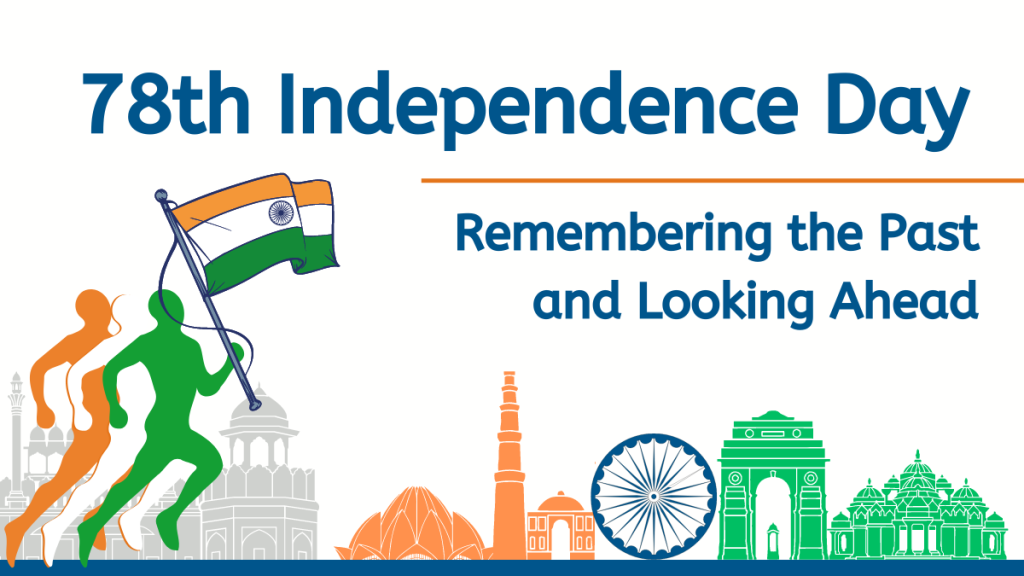Indian Independence Day is not just any occasion but one filled with extreme pride and patriotic fervor for each and every Indian throughout the world, celebrated uniquely each year on the 15th of August. This day marked the historic occasion in 1947 when India finally shook off the shackles of British colonial rule after a period of almost two centuries of suffering and sacrifice. This day not only commemorates with supreme honors but also celebrates the very historical day and richly diversified cultural syndrome of India, which culminated into its march ahead toward emerging as a sovereign state.

As another Independence Day approaches, it is important to pause and think over what this day really means to all of us. This day is more than just parades, flag hoistings, and cultural functions; it’s a day for introspection into the sacrifice of thousands of freedom fighters, who showed selflessness during their fight, and a day to rededicate oneself to the ideals of democracy, unity, and justice. Within the context of today, the day is even of greater significance, reminding us of certain values that form the building of modern India are falling on us as citizens to continue building a nation that holds these. This 78th Independence Day, let us celebrate the glory of our country. The day is for saluting the architects of our freedom and reminding a new generation to carry their legacy forward for a progressive and united India.
Theme of the 78th Indian Independence Day
The theme of India’s 78th Independence Day in 2024 is “Viksit Bharat,” which can be translated to “Developed India.” It coincides with the ambitious vision put forth by the Indian government to transform the country into a fully developed nation by 2047, the centenary of India’s independence.
“Viksit Bharat” relates to all-round development in the broad sectors of economy, social upliftment, environmental sustainability, and good governance. It aims to place India as a strong global economy with a good living standard for its citizens. This initiative aims at developing entrepreneurship, innovation, and competitiveness to achieve sustained economic growth. It also focuses on social inclusiveness, whereby each citizen should have access to the fundamental rights that come their way and are given opportunities, thereby rendering equality and diversity.
The youth play a key role in the vision of “Viksit Bharat”. With a high percentage of India’s population below the age of 35, their participation is perceived as imperative to bring about change and innovation in the nation. The government has taken several initiatives to engage youth in determining the future of the country, calling upon them to share their ideas and join discussions through means like MyGov.
The theme of “Viksit Bharat” for Independence Day 2024 thus alludes to an aspirational, all-inclusive, and sustainable India, which is strong on the global stage by the time it celebrates its 100th year of independence in 2047.
Historical Context: British Colonization and Its Impact on India
British colonization in India was rooted early in the 17th century when the British East India Company was established as a trading entity. Gradually, the company developed and became the ruler of great territories in India. A critical turn took place after the Battle of Plassey in 1757 which initiated British political dominance in India. Over the following hundred years, the British established their system, especially exploiting resources from India, imposing taxes, and restructuring the economy for British interests.
British colonization had a devastating impact on India. On the one hand, the traditional industries, especially in textiles, were pulled down to the advantage of British manufacturers; on the other hand, this led to gross poverty and unemployment. The implementation of the Zamindari and Watanji customs of tax revenue had also left the Indian peasant with no other option but the prospect of unbroken famine. British policymaking was also social in nature, as they wanted to implant a sense of racial pride and they marginalized Indians from the mainstream and alienated them from taking part in governance. It was during this period that Western education and Western thoughts began to percolate, but at the same time, they were creating the initial sparks for resistance and sowing the seeds for the inevitable struggle for independence.
Catalysts of the Independence Movement
Many leaders and their special contributions to the movement made the Indian independence movement, but one iconic leader in the struggle against British rule was Mahatma Gandhi. His philosophy of ‘Ahimsa’ and the use of civil disobedience inspired millions to fight for independence. His leadership in the Non-Cooperation Movement of 1920-1922 and the Salt March of 1930 demonstrated, above all, the potential strength brought forth by mass mobilization and peaceful resistance.
Another notable leader in India’s struggle for independence was Jawaharlal Nehru, who played a pivotal role in articulating the aspirations of a free India. He was the closest associate of Gandhi, and his articulation on a secular, socialist, and democratic India was a vision shared by most. His leadership in the Quit India Movement in 1942 further galvanized the nation.
Subhas Chandra Bose gave another entirely different methodology to the Indian freedom struggle. Fed up with the passivity of the Gandhian non-violent way, Bose approached the independence process to get active. He formed the Indian National Army (INA) and fought alongside Axis powers during World War II.
Certain events sped up the process of India’s emancipation from the British: the Partition of Bengal in 1905 inspired nationalistic feeling, thus giving birth to the Swadeshi Movement. Another point came with the Jallianwala Bagh Massacre in 1919, where the British killed several unarmed civilians, highlighting the demand for total independence.
It was the final phase of this struggle that witnessed the mounting pressure of World War II on the British Empire, the naval mutiny of 1946, and the negotiations that eventually led to the Partition of India and Pakistan in 1947. This period was full of glory and agony: independence at a colossal cost, immense communal violence, and the displacement of millions during the partition.
Philosophies and Ideas Behind the Indian Independence Movement
The Indian independence movement was stirred by an intrinsic sense of liberty that assumed diverging philosophies and values. The very core of such freedom notions was self-rule, a concept propounded by the likes of Bal Gangadhar Tilak and then later carried forward by Gandhi. Swaraj was projected as nothing less than the right of Indians to rule, to bring back their glory and identity that had been taken by the dirty yoke of colonialism.
Non-violence and civil disobedience were the basis upon which Gandhi worked. It was so effective since his belief in the moral supremacy of non-violence brought international sympathy for the Indian cause. Indian traditions of religious-cum-cultural life were what Mahatma Gandhi delved deep into and which motivated his emphasis on the twin virtues of truth (Satya) and non-violence (Ahimsa). One more major aspect of the movement was social justice. The leaders advocated the cause of internal social inequalities, mainly against caste discrimination: along with the freedom struggle against the colonial masters and the movement for equality and justice for every Indian.
Modern democratic India was presaged in the spirit of freedom. Nehru’s secular, socialist, and scientific temper embodied the rationalistic yearnings of a land that has yearned to create a just and progressive society, praying for no twilight dominating over it, be it of the subjugation of one over another.
Therefore, the independence movement of India was not just a fight against colonial rule; it was a struggle, broad in meaning, for human dignity, equality, and self-determination. It is this movement that united all people: from regions, religions, and classes, it united their struggle and vision for a free and prosperous India.
Reflection on India’s Progress Since Independence
Political and Economic Achievements
Adoption of the Constitution (1950):
One of the most memorable movements in Indian history immediately after the freedom struggle was the adoption of its Constitution on 26 January 1950. This formed the basis for India’s becoming a sovereign, democratic, secular republic. The Constitution laid down the fundamental rights and duties of the people but prescribed a scheme of governance that would provide for checks and balances through the distribution of powers between the executive, legislature, and judiciary. It has been the cornerstone in maintaining India’s unity and integrity while accommodating its vast diversity.
Industrialization and Economic Growth:
Very soon after independence, India began a process of quick industrialization by adopting a model of mixed economy with significant state involvement. The central government targeted building an independent nation and went on its way to adopt a host of steps towards fulfilling it. It included building massive public sector undertakings in segments like steel, coal, and heavy machinery. It was during this time that the government introduced the initiative of the Five-Year Plans which aimed at the development of infrastructure, increased agricultural productions, and diversified industries.
Green Revolution: 1960s–1970s
The Green Revolution was a landmark in India’s agricultural history. With the introduction of high-yielding varieties of seeds and making enough fertilizers available for better plant growth, coupled with improved irrigation techniques, India rose from the status of a food-deficient nation to being one of the largest producers of wheat and rice in the world. This revolution not only achieved self-sufficiency in food but also reduced dependence on food imports and resulted in significant rural development and poverty alleviation.
Economic Liberalization, 1991:
The year 1991 was a watershed moment for India’s economic policy. It was then passing through the acute crisis of the balance of payments; India opened up its economy to world markets and initiated deregulation of industries, reducing governmental control over businesses. There was a huge foreign investment that flowed in with the liberalization, rapid technological progress, and the private sector rising to take center stage, thereby transforming India into one of the fastest-growing major economies in the world. This liberalization also fueled growth in the IT and services sectors, helping India emerge as a global platform for software development and outsourcing.
Social Progress
Education:
No doubt, India has done quite well in education since independence. The emphasis of the government on increasing access to primary and secondary education resulted in high literacy rates, increasing from around 18% in 1951 to over 77% in recent years. Starting from massive initiatives such as the Right to Education Act, of 2009, and the Mid-Day Meal Scheme to opening numerous higher education institutions, these have contributed massively to increased school enrollment and retention. Opening numerous higher education institutions has created opportunities for millions of Indians to contribute meaningfully to the country’s growing knowledge economy.
Healthcare:
There has been marked improvement in the Indian healthcare system, particularly in the reduction of mortality rates and control of diseases. Among the best achievements have been the successful eradication of smallpox in the 1970s and the near-eradication of polio. Successive governments have implemented the National Rural Health Mission and Ayushman Bharat for improved health access in rural areas. Despite serious challenges, India has been able to make great strides in public health that have, in turn, upgraded life expectancies and raised maternal and child health outcomes.
Women’s Rights
India has come a long distance since Independence in the matter of women’s rights and social justice. The Constitution guarantees equality before the law and prohibits discrimination on grounds of gender, caste, or religion. Different laws and policies for protecting the rights of women have been passed; these include dowry prohibition, domestic violence, and maternity benefit acts. The social justice initiatives—the reservations in education and employment for Scheduled Castes, Scheduled Tribes, and Other Backward Classes—have played an important role in overcoming historical inequalities and empowerment of the downtrodden.
India’s Role on Global Arena
A fledgling nation at the time of freedom, India has steadily risen to prominence in world affairs. It is the largest democracy in the world and exercises a considerable position within international organizations such as the United Nations, the G20, BRICS, and the Non-Aligned Movement. Its autonomous strategic foreign policy has placed India in a position where close ties could be built up with different nations while pursuing peace and developmental goals globally.
During the last few decades, India has emerged as one of the major players in global economic affairs, is one of the fastest-growing economies, and has demographic advantages. It also plays a very crucial role in various global peacekeeping missions and engages prominently with several other nations in various discussions related to global challenges and concerns on matters such as climate change and sustainable development. The Indian space program, with missions such as Chandrayaan and Mangalyaan, has further made India one of the most talked-about nations in science and technology.
Thus, India has come out of being an emerging nation, fresh from the shackles of colonialism, to that of a global power today, founded on democratic values, economic resilience, and a commitment toward social justice. Further movement in this vision will enlighten the way ahead for new conquests in development through “Viksit Bharat” in 2047.
Conclusion
As we celebrate the 78th anniversary of Independence Day, the thought which ought to stir our minds is in regard to the journey that India, as a nation, has been undertaking ever since 1947. From the rigorous battles against colonial oppression and the celebrations of freedom to the adoption of a strong Constitution, and, finally, to India rising as a global power, the very story is one of resilience, diversity, and progress. The “Viksit Bharat” theme draws its inspiration from that inheritance, urging us to rise and work together for a fully developed nation in 2047, wherein each citizen gets to enjoy freedom, equality, and prosperity.
This 78th Independence Day should be a celebration not only of the past but also a commitment to democratic values, unity, and social justice. This is an appeal for every Indian to join in this unfinished journey of the nation in progress toward greatness: making sure that the sacrifices made by our freedom fighters are not in vain, but the nation they would have loved and cherished can be presented to the world through inclusiveness and progress, standing strong on the world platform.
As we hoist the tricolor on August 15, let us once again remember our history, celebrate our achievements, and decide our commitment to the future of “Viksit Bharat.” The day reminds us that the spirit of independence lives on, beckoning all toward contributing to a brighter, more prosperous India for generations yet to come.
To help you prepare 50% faster for competitive exams, ixamBee provides a free Mock Test Series and all the Current Affairs in English and Current Affairs in Hindi in the BeePedia capsules for GA Preparation. You can also get the latest updates for Bank PO, Bank Clerk, SSC, RBI Grade B, NABARD, and Other Government Jobs.
Also Read:
Important Days of February 2024: List of National and International Events
Evolution of the Panchayati Raj System in India















